 his first section covers 1992-1993, my first introduction to life in a design studio. Since I didn't know what the fuck I'm doing (and I probably still don't), and I couldn't draw or draught, I figured that building elaborate basswood models might get me passing grades.
his first section covers 1992-1993, my first introduction to life in a design studio. Since I didn't know what the fuck I'm doing (and I probably still don't), and I couldn't draw or draught, I figured that building elaborate basswood models might get me passing grades.

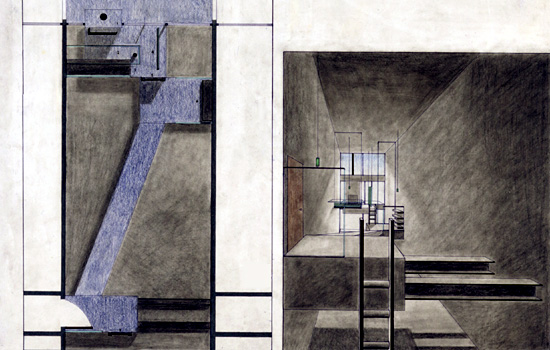
November-December 1992
 nspired by J.G. Ballard's apocalyptic new wave sci fi novel High Rise, this imaginary reading room explored the various themes underlying that rather disturbing literary work: how architecture can affect behaviour and socialisation, animal instincts vis-à-vis the modern brave new world, insecurity and paranoia, existential crisis, and even vertigo.
The instructors for this fall 1992 ED11B project were Verda Alexander, Udo Greinacher, and Tom Powers.
The image above shows plan and perspective, while the image below shows sectional views.
nspired by J.G. Ballard's apocalyptic new wave sci fi novel High Rise, this imaginary reading room explored the various themes underlying that rather disturbing literary work: how architecture can affect behaviour and socialisation, animal instincts vis-à-vis the modern brave new world, insecurity and paranoia, existential crisis, and even vertigo.
The instructors for this fall 1992 ED11B project were Verda Alexander, Udo Greinacher, and Tom Powers.
The image above shows plan and perspective, while the image below shows sectional views.
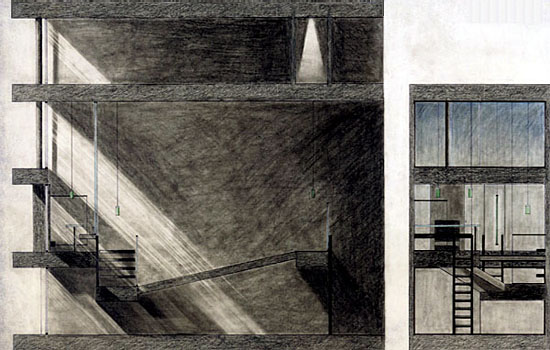


September 1993
 his assignment marked the beginning of what became the most productive period of my life.
Sleep deprivation notwithstanding, Arch. 100A of fall 1993 with Stanley Saitowitz and Gary Strang was quite an experience (even though the former was added to my shit list for being himself). I was actually getting things done. Without the burden of family problems or serious relationships, I was extremely focused on working hard and being as outrageous as possible (in a sincere manner, of course). I also learned a lot, and everything seemed possible. How young and naive I was!
his assignment marked the beginning of what became the most productive period of my life.
Sleep deprivation notwithstanding, Arch. 100A of fall 1993 with Stanley Saitowitz and Gary Strang was quite an experience (even though the former was added to my shit list for being himself). I was actually getting things done. Without the burden of family problems or serious relationships, I was extremely focused on working hard and being as outrageous as possible (in a sincere manner, of course). I also learned a lot, and everything seemed possible. How young and naive I was!
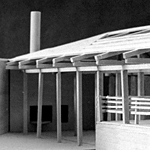 This is a view of the interior of the shelter. (Click image for enlarged, non-cropped version.)
This is a view of the interior of the shelter. (Click image for enlarged, non-cropped version.)
|
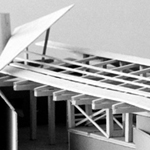 An image of the study model.
An image of the study model.
|
 he programme for this three-week project originally entailed the design of a resting station for travellers in the context of a flat, featureless, harsh, and unidentified desert landscape. It would provide visitors with only the essentials intrinsic to survival: water, fire, and shelter.
As a protective, subterranean womb for travellers, the project sought to establish a distinctive sense of place while integrating itself into the hostile emptiness of the desert.
he programme for this three-week project originally entailed the design of a resting station for travellers in the context of a flat, featureless, harsh, and unidentified desert landscape. It would provide visitors with only the essentials intrinsic to survival: water, fire, and shelter.
As a protective, subterranean womb for travellers, the project sought to establish a distinctive sense of place while integrating itself into the hostile emptiness of the desert.

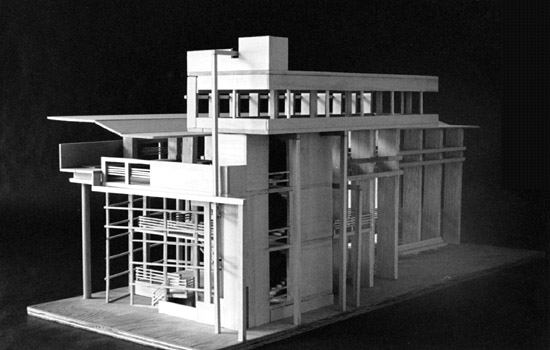
October 1993
 ith Le Corbusier's simple maison domino concrete frame as a starting point and working within the confines of a delicate 50' x 130' urban site in the Rockridge shopping district of Oakland, this four-week Arch. 100A project attempted to address and comment on issues ranging from urbanism and the celebration of the public realm to the "decorated shed" and the excesses of consumption in our society. When looking at our decidedly non-Corbusian looking projects, Stanley kept asking, "But where's the domino??"
"Up yer bloody arse, Stanley!" I wanted to shout.
Anyway, one of the instructors of the studio, the ever-charming Toby Levy, said during the disastrous review that she didn't think this "smart-ass project should deserve any comments" from her. Whatever it is, it's not about bicycles.
ith Le Corbusier's simple maison domino concrete frame as a starting point and working within the confines of a delicate 50' x 130' urban site in the Rockridge shopping district of Oakland, this four-week Arch. 100A project attempted to address and comment on issues ranging from urbanism and the celebration of the public realm to the "decorated shed" and the excesses of consumption in our society. When looking at our decidedly non-Corbusian looking projects, Stanley kept asking, "But where's the domino??"
"Up yer bloody arse, Stanley!" I wanted to shout.
Anyway, one of the instructors of the studio, the ever-charming Toby Levy, said during the disastrous review that she didn't think this "smart-ass project should deserve any comments" from her. Whatever it is, it's not about bicycles.
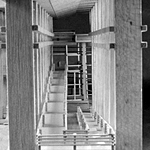 An image of the view of the project from the west. (Click image for enlarged, non-cropped version.)
An image of the view of the project from the west. (Click image for enlarged, non-cropped version.)
|
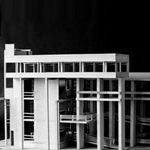 A view of the north elevation.
A view of the north elevation.
|
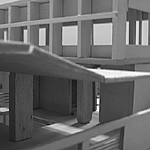 A view of the covered rooftop terrace.
A view of the covered rooftop terrace.
|
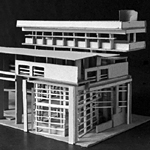 An image of the study model.
An image of the study model.
|
 uring this period, I began to gain a bit of notoriety for my reviews at crits. Although sincere and totally honest, I had a tendency to make what were perceived to be outrageous statements. My views on architecture often clashed with my reviewers, and I wasn't afraid to go after their hypocrisy or stupidity. Since heated exchanges at reviews were a fun way to keep myself awake from dull crits, I almost began to court them.
Some classmates thought that I was a masochist, and I concede that in my undergraduate studios, I was always itching for a fight. There are few things as bad in life as a boring crit. Here's how I began to feel about crits. You shouldn't give a bloody rat's arse what jurors say in crits unless you feel it's interesting and /or insightful. If good, strong criticism is given, then you should take it and appreciate it.
Sometimes these really hurt initially because you know that in the end what they're saying it's true. However, usually these are the best kind of crits because, like taking medicine, it may feel nasty at first, but it's actually good for you in the long run. You learn from it. That's how you really learn in life-- through pain. On the other hand, if you feel it's unjustified, here's your great opportunity to have a bit of fun and go after the fucking bastards 'cause nothing wakes people up more than a lively arguement.
Fuck grades and potential employers and really impress your mates! Tell the reviewers they're full of shit.
Show 'em you're the fucking bad-ass who shouldn't be messed with.
Always remember that positive feedback from jurors in a crit are usually useless since you rarely really learn from them, and most of all, they're as boring as hell for everyone else. In the end, be your own best juror and never listen to anybody unless you feel they really have something worthwhile (and always hope for negative reviews).
uring this period, I began to gain a bit of notoriety for my reviews at crits. Although sincere and totally honest, I had a tendency to make what were perceived to be outrageous statements. My views on architecture often clashed with my reviewers, and I wasn't afraid to go after their hypocrisy or stupidity. Since heated exchanges at reviews were a fun way to keep myself awake from dull crits, I almost began to court them.
Some classmates thought that I was a masochist, and I concede that in my undergraduate studios, I was always itching for a fight. There are few things as bad in life as a boring crit. Here's how I began to feel about crits. You shouldn't give a bloody rat's arse what jurors say in crits unless you feel it's interesting and /or insightful. If good, strong criticism is given, then you should take it and appreciate it.
Sometimes these really hurt initially because you know that in the end what they're saying it's true. However, usually these are the best kind of crits because, like taking medicine, it may feel nasty at first, but it's actually good for you in the long run. You learn from it. That's how you really learn in life-- through pain. On the other hand, if you feel it's unjustified, here's your great opportunity to have a bit of fun and go after the fucking bastards 'cause nothing wakes people up more than a lively arguement.
Fuck grades and potential employers and really impress your mates! Tell the reviewers they're full of shit.
Show 'em you're the fucking bad-ass who shouldn't be messed with.
Always remember that positive feedback from jurors in a crit are usually useless since you rarely really learn from them, and most of all, they're as boring as hell for everyone else. In the end, be your own best juror and never listen to anybody unless you feel they really have something worthwhile (and always hope for negative reviews).

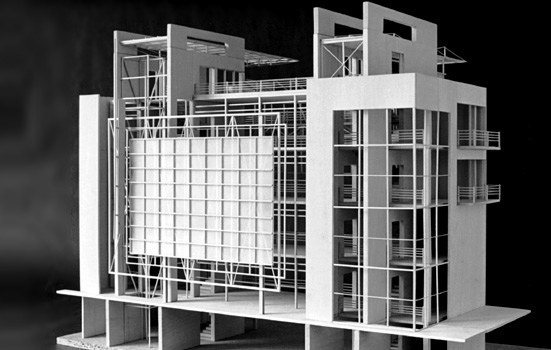
November-December 1993
 s an exercise examining Louis Kahn's concept of servant and served spaces, this thrid and final project for Arch. 100A entailed the design of a compact library housing historical documents on a tiny 30'x80' lot facing San Francisco's Moscone Convention Center. (Somewhat unfortunately as a student of architecture, it's rarely possible to go through school without having to design some kind of a library.) Despite the dimunitive scale of the site, the design tried to establish a strong sense of identity as an important public institution among the overwhelming scale of the formidable urban environment while addressing such disparate concerns as clarity of plan and structure, efficient circulation, and appropriate interior lighting for both books and patrons.
Here are more images for your edification:
s an exercise examining Louis Kahn's concept of servant and served spaces, this thrid and final project for Arch. 100A entailed the design of a compact library housing historical documents on a tiny 30'x80' lot facing San Francisco's Moscone Convention Center. (Somewhat unfortunately as a student of architecture, it's rarely possible to go through school without having to design some kind of a library.) Despite the dimunitive scale of the site, the design tried to establish a strong sense of identity as an important public institution among the overwhelming scale of the formidable urban environment while addressing such disparate concerns as clarity of plan and structure, efficient circulation, and appropriate interior lighting for both books and patrons.
Here are more images for your edification:
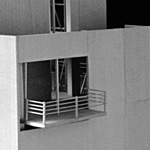 An image of the south-east fašade is availble here. The wall had been removed from the model to reveal the interior stacks.
(Once again, click image for enlarged, non-cropped version.)
An image of the south-east fašade is availble here. The wall had been removed from the model to reveal the interior stacks.
(Once again, click image for enlarged, non-cropped version.)
|
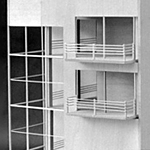 A view of the south-west side of the project.
A view of the south-west side of the project.
|
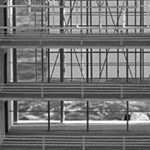 Another view of the south-east side of project. Again, the wall had been removed from the model to reveal the interior stacks.
Another view of the south-east side of project. Again, the wall had been removed from the model to reveal the interior stacks.
|
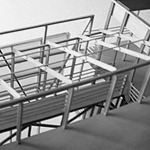 A detailed view of the rooftop catwalk.
A detailed view of the rooftop catwalk.
|
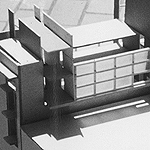 An image of an early reiteration of the project.
An image of an early reiteration of the project.
|
 ctually, there's a bit more to the project. The following sob story may partially explain why I'm somewhat reluctant to provide drawings to these projects online (in addition to the fact that they're a total bitch to reproduce and exhibit well online). Please indulge me and let me be a self-absorbed, burning martyr here for a moment.
The original quarter inch-scale basswood model, largest in that studio incidentally, and admittedly crappy presentation drawings drawings for this library project were all stolen from my desktop on the 7th floor studio of Wurster Hall after the final review, but before I had a chance to photograph and properly document them.
Everything gone. No trace left. Needless to say, the sense of loss was quite severe since it was my least offensive project up to that date and most developed student work to-date; the sheer size and scope of detail of the model were enough to impresss everyone at the crit. Talk about the effort: I didn't sleep or bathe for nearly three fucking days.
Considering that it was December 1993 and I had a final for arch170a the next day, I was in pretty bad shape in every respect.
How was I to study for a bleeding fucking final when I had just lost my dear baby? Initial painful and pathetic attempts by me and friends to recover my project proved to be futile, and to make a long story short, I began the process of rebuilding the entire model a week later. Although my friends were quite supportive, to start something all over again after spending so much time, energy, and resources was still very difficult. My sense of loss and anger were overwhelming, but what else can you do? How can someone do such a thing? What's the point of being in architecture if you just steal someone else's work? Isn't the whole point of the game about building one's creativity and originality? What does all this say about true nature of my fellow architecture students? Did I lose my faith in humanity? Well, almost. I just tried to forget about it and get on with life again.
ctually, there's a bit more to the project. The following sob story may partially explain why I'm somewhat reluctant to provide drawings to these projects online (in addition to the fact that they're a total bitch to reproduce and exhibit well online). Please indulge me and let me be a self-absorbed, burning martyr here for a moment.
The original quarter inch-scale basswood model, largest in that studio incidentally, and admittedly crappy presentation drawings drawings for this library project were all stolen from my desktop on the 7th floor studio of Wurster Hall after the final review, but before I had a chance to photograph and properly document them.
Everything gone. No trace left. Needless to say, the sense of loss was quite severe since it was my least offensive project up to that date and most developed student work to-date; the sheer size and scope of detail of the model were enough to impresss everyone at the crit. Talk about the effort: I didn't sleep or bathe for nearly three fucking days.
Considering that it was December 1993 and I had a final for arch170a the next day, I was in pretty bad shape in every respect.
How was I to study for a bleeding fucking final when I had just lost my dear baby? Initial painful and pathetic attempts by me and friends to recover my project proved to be futile, and to make a long story short, I began the process of rebuilding the entire model a week later. Although my friends were quite supportive, to start something all over again after spending so much time, energy, and resources was still very difficult. My sense of loss and anger were overwhelming, but what else can you do? How can someone do such a thing? What's the point of being in architecture if you just steal someone else's work? Isn't the whole point of the game about building one's creativity and originality? What does all this say about true nature of my fellow architecture students? Did I lose my faith in humanity? Well, almost. I just tried to forget about it and get on with life again.
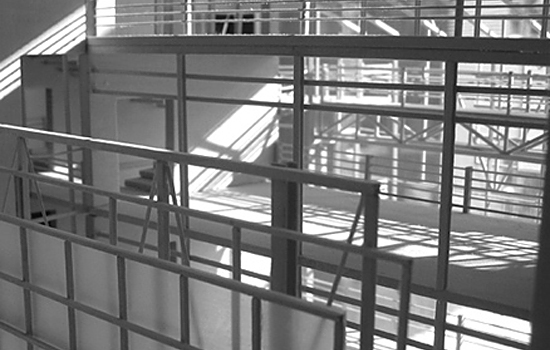
 ere's how I rationalised it.
I mean, if the Japanese and the Germans had just given up and not rebuild their respective nations after they were thoroughly defeated in 1945, where would they be today? Banana republics threatened with draconian IMF interventions and unspeakable birth rates? Stagnant controlled economies without the means to lift them out of a permanent state of deprivation? No, giving up was never a conceivable option and certainly not the right attitude. Strong guys like me don't give up. Especially strong guys with their minds intact. They might have taken away drawings and the model, but they didn't take away the brain. I don't want to be the design equivalent of a stagnant, God-forsaken third-world backwater. No, I want to be a member of GATT and G-7. I want a formidable gross domestic product. I want the whole world at its knees. I want it all, dammit! (Oops, I think I should stop myself now before this turns into another one of my Cartman-esque diatribes.)
ere's how I rationalised it.
I mean, if the Japanese and the Germans had just given up and not rebuild their respective nations after they were thoroughly defeated in 1945, where would they be today? Banana republics threatened with draconian IMF interventions and unspeakable birth rates? Stagnant controlled economies without the means to lift them out of a permanent state of deprivation? No, giving up was never a conceivable option and certainly not the right attitude. Strong guys like me don't give up. Especially strong guys with their minds intact. They might have taken away drawings and the model, but they didn't take away the brain. I don't want to be the design equivalent of a stagnant, God-forsaken third-world backwater. No, I want to be a member of GATT and G-7. I want a formidable gross domestic product. I want the whole world at its knees. I want it all, dammit! (Oops, I think I should stop myself now before this turns into another one of my Cartman-esque diatribes.)
 nyhoo, I originally wanted to reconstruct my project in exactly the same manner without any alterations.
I figured that the loser who had stolen my project wanted to use it in his portfolio and that I should replicate my project in the hope that one day some grad school administrator or potential employer would recognise the duplication, and I would find out who the bloody perpetrator was. However, redoing the project took so long that my perspective on the whole project inevitably shifted. I realised that I had an opportunity to improve on the original scheme, produce a better design, and build an even more well-crafted model. (The changes eventually entailed bringing in even more light into the reading and office areas and refining some stylistic gestures.) After three semesters and one summer break, I finally completed the model in May 1995. Life goes on.
nyhoo, I originally wanted to reconstruct my project in exactly the same manner without any alterations.
I figured that the loser who had stolen my project wanted to use it in his portfolio and that I should replicate my project in the hope that one day some grad school administrator or potential employer would recognise the duplication, and I would find out who the bloody perpetrator was. However, redoing the project took so long that my perspective on the whole project inevitably shifted. I realised that I had an opportunity to improve on the original scheme, produce a better design, and build an even more well-crafted model. (The changes eventually entailed bringing in even more light into the reading and office areas and refining some stylistic gestures.) After three semesters and one summer break, I finally completed the model in May 1995. Life goes on.
 ll things considered, I still like to to beat the shit out of whomever stole my project.
ll things considered, I still like to to beat the shit out of whomever stole my project.


Reach us at 'bcbloke' on all the usual social media platforms



























